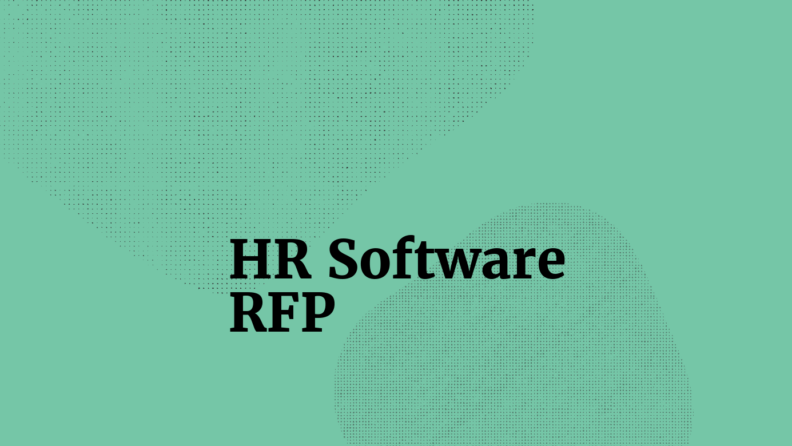An RFP, or Request for Proposal, is a formal document you use when you need to find the right software vendor for your company. If you've been tasked with finding a new HR software solution for your team, this guide will help you tackle the RFP process with confidence.
Crafting a solid RFP makes comparing vendors easier and helps you avoid costly mistakes. Essentially, when you write an RFP, you clearly outline what your team needs and why. Doing so helps you see which vendors can meet those needs and reduces the risk of picking the wrong one. That’s why it’s crucial to get this process right.
Writing an RFP helps you clearly outline your needs, making it easier to compare vendors and find the best fit for your team.
If your organization is small or the requirements are simple, you might skip the RFP and contact vendors directly for quotes.
A well-crafted RFP can lead to a better software fit and more competitive pricing, saving your team time and money.
Do You Actually Need an RFP?
An RFP becomes essential when you're dealing with complex HR needs or operating in a regulated industry. If your team is large or your processes are intricate, an RFP helps ensure you don't miss vital requirements and makes it easier to compare vendors. It's also crucial when you have to justify spending or need stakeholder buy-in.
Consider writing an RFP in these situations:
- Large-scale HR system overhaul
- Compliance with industry regulations
- Multiple stakeholders involved
- Significant budget investment
- Custom integration requirements
When an RFP Might be Overkill
If you're part of a small team with straightforward needs, an RFP might not be necessary. You can avoid the hassle if your budget is limited or you're looking for simple, off-the-shelf solutions. If you’re in this situation, below are my top choices of HR software to consider (including HRIS, HRMS, and HCM providers).
Top HR Software To Consider
Here’s my list of the top 10 HR software options available, to help you get started in your search:
RFI vs RFP vs RFQ: What’s the Difference?
Understanding the differences between RFI, RFP, and RFQ can save you time and help you choose the right approach for your purchase. Not every situation calls for an RFP; sometimes, an RFI or RFQ will do the job. Picking the right document can streamline the process and reduce hassle.
Here's a quick comparison to guide your decision:
| Document Type | Purpose | When to Use | What to Include | Level of Detail Required |
|---|---|---|---|---|
| Request for Information (RFI) | Gather general info and options | When you're exploring available solutions and need to understand the market | Basic questions about capabilities and offerings | Low |
| Request for Proposal (RFP) | Solicit proposals from selected vendors for specific requirements | When you have specific needs and want to compare detailed vendor proposals | Detailed requirements, scope, and evaluation criteria | High |
| Request for Quotation (RFQ) | Obtain pricing for specific tools or services | When you know exactly what you need and just want price quotes | Specific services or products required | Medium |
Common RFP Mistakes to Avoid
Rushing through an RFP or skipping key details can lead to confusion, wasted time, or vendors that don't fit your needs. By steering clear of common pitfalls, your team can create a smoother HR software selection process.
Below, I’ll explore some common mistakes to watch out for.
Insufficient Background or Context
Without enough background or context, vendors can't tailor their proposals to your organization’s needs. This leads to generic responses that don't address your specific challenges.
Make sure you provide a clear picture of your current systems, challenges, and goals so vendors can offer relevant solutions.
Missing or Unclear Budget
If you don't share a budget or it's vague, you might get proposals that are way off the mark. Presenting your budget upfront helps vendors tailor their offerings, ensuring you only get proposals within your budget range.
Being transparent about what you're willing to spend can save time for both sides. However, it’s also important to go into this process with a realistic understanding of typical HR software pricing too.
Vague Requirements or Legal Jargon
Vague requirements may confuse vendors and lead to proposals that don't meet your needs.
Avoid using legal jargon that can obscure what you're asking for. Clearly outline what you want, using plain language, so vendors know exactly what's expected.
No Evaluation Criteria Shared
Without clear evaluation criteria, you're left guessing which proposal is best. This causes delays and frustration for your team.
To combat this, share how you'll evaluate proposals, whether it's based on cost, features, or support, so vendors can align their proposals with your priorities. If you can, provide potential vendors with a standardized evaluation framework to fill out to further streamline your RFP responses.
No Standard Format for Vendor Responses
If vendors respond in different formats, comparing them becomes a headache. It wastes time and makes it hard to see which is the best fit.
Instead, provide a standard RFP template, including a table of contents that outlines how you want information presented. Doing so can further streamline the review process, making it more straightforward to compare vendor responses.
Assemble Your HR Software RFP Team
Creating a strong RFP isn’t a solo job. The best RFPs reflect the input and needs of a cross-functional group, ensuring all aspects are covered. Involving the right key stakeholders from the start helps reduce risk and avoid rework later.
Here's who you should involve:
Project Sponsor
The project sponsor provides the overall vision and ensures the RFP aligns with company goals. They can help secure necessary resources and make high-level decisions.
Typically, this role is filled by someone in senior management, such as a VP of HR or a Chief Operating Officer.
Functional Experts
Functional experts bring in-depth knowledge of specific HR processes and requirements. Their input ensures the RFP addresses technical needs and operational challenges.
This group often includes HR managers, payroll specialists, benefits coordinators, or other key HR team members.
Procurement or RFP Writers
Procurement or RFP writers have the expertise to craft clear and concise documents. They ensure compliance with procurement policies and handle vendor communication.
These roles are usually filled by procurement officers or dedicated RFP specialists within your team.
End Users and Stakeholders
End users and stakeholders provide insights into daily challenges and desired features. They help ensure the software meets practical needs and boosts productivity.
This group can include HR staff, department heads, or even employees from other departments who will interact with the software. In smaller companies, your Functional Experts may also fulfill this category in your RFP team too.
Define Must-Haves & Goals
Before sending an RFP, your team needs to clearly define what the new solution must do, and why. For example, are you looking for specific modules your current HR software doesn’t have? Or are you trying to improve your employee data management practices with an all-in-one system, or increase self-service capabilities?
Aligning around pain points, goals, and non-negotiables helps vendors respond more accurately and makes it easier to evaluate proposals.
Here are some key factors to consider:
- Pain points with the current system: What frustrates your team about the current setup? Maybe data entry is cumbersome, or reporting tools are lacking. Pinpoint these issues so vendors know what they need to fix.
- Required improvements and success outcomes: What does success look like for your team? Perhaps you want faster onboarding, or integrated benefits administration. Define these improvements to guide vendors in crafting their proposals.
- Functional, technical, and compliance needs: Does the software need to integrate with payroll, or meet specific industry regulations? Detail these requirements so vendors can ensure compatibility and compliance.
- User roles, usage levels, workflows: Who will use the software and how often? Outline user roles and typical workflows to ensure the solution supports your team's daily activities.
- Deployment preferences: Do you prefer a cloud-based solution or on-premises installation? Specify your deployment preferences to help vendors tailor their offerings to your infrastructure.
Write the HR Software RFP
Now it’s time to put everything together in a clear, structured RFP document. A well-organized, complete RFP makes it easier for vendors to respond accurately and for your team to evaluate those responses efficiently. Here's what to include:
1. Executive Summary
The executive summary should provide a brief overview of your project and objectives. Explain why you're seeking a new HR software and what you hope to achieve.
This section sets the tone for the rest of the RFP, so keep it concise and focused. Vendors should quickly understand your main goals and the impact you’re aiming for.
2. Scope of Work
Clearly outline the scope of work, detailing what you expect from the software and the vendor.
Include key deliverables, timelines, and any specific tasks you need completed. This helps vendors understand the project's boundaries and ensures they're prepared to meet your expectations.
3. Technical Requirements
List the technical requirements your team needs, such as integration capabilities or supported platforms.
Be specific about system compatibility—like whether it needs to work with existing HR tools or databases. This ensures vendors can provide solutions that fit seamlessly into your current setup.
4. Vendor Qualifications
Specify the qualifications you expect from vendors, such as industry experience or certifications.
Describe any past projects that align with your needs to gauge their expertise. This helps you narrow down vendors who truly fit your criteria and can deliver what you need.
5. Security and Compliance Needs
Detail your security and compliance requirements, including HR data protection standards or regulatory obligations.
Make sure vendors understand your industry’s specific needs, like GDPR or HIPAA compliance. This ensures you partner with vendors who prioritize security and adhere to necessary regulations.
6. Implementation and Training Expectations
Outline your expectations for the training and implementation process, including timelines and the level of customer support needed.
Describe any training programs or resources you’ll require to get your team up to speed. This helps vendors plan their approach and ensures a smooth transition to the new software.
7. Pricing and Licensing
Ask for detailed pricing information, including any licensing fees, maintenance costs, or additional charges.
Clarify whether you prefer a subscription-based model or a one-time purchase. This transparency helps you compare costs and choose a solution that fits your budget.
8. Contract Terms
Define the contract terms you expect, covering aspects like duration, renewal options, and termination clauses.
Be clear about any legal or financial conditions that are non-negotiable. This sets clear expectations and protects your interests in the vendor relationship.
9. Submission Instructions
Provide clear submission instructions, including deadlines and the RFP template format you expect responses in.
Specify any documents or information vendors must include in their proposals to facilitate decision-making. This ensures you receive complete, organized responses that are easy to evaluate by key stakeholders.
Define Your Evaluation Criteria
Clearly defined evaluation criteria help keep the decision process objective, transparent, and aligned with your business goals. Establish your criteria before reviewing proposals to avoid bias and ensure consistency.
Here's how to define your evaluation criteria:
What Matters Most?
Choose 3–5 weighted categories that align with your goals and priorities. This focus helps your team evaluate what's truly important. Common RFP scoring categories for HR software include:
- Cost effectiveness
- Functionality
- Vendor reputation
- User experience
- Implementation support
Use a Scoring Matrix
A scoring matrix helps you systematically evaluate each proposal. Assign weightings to your categories based on their importance, like giving more weight to functionality if it's a top priority.
Score each criterion on a 1–5 or 1–10 scale to differentiate the proposals clearly. Adjust the weightings to reflect what matters most to your team.
Clarify Your Scoring Process
Define who will score the proposals and how it will be done. Use a standardized rubric to ensure consistency and fairness in evaluations.
Schedule a meeting to align reviewers on the scoring approach before diving into the proposals. This alignment helps avoid misunderstandings and keeps everyone on the same page.
Issue the HR Software RFP
Issuing the RFP isn’t just about sending it out—it’s about giving vendors the right access, timelines, and instructions so they can respond effectively.
A smooth distribution process sets the tone for the quality of proposals you’ll get back. Here's how to issue your RFP:
Choose the Right Distribution Method
Common distribution options include email, RFP software platforms, or procurement portals. Use a centralized system to track responses, ensuring nothing falls through the cracks.
Consider providing a vendor contact list or using a role-based inbox for clarity, which helps manage communications efficiently. This approach streamlines the process and keeps everything organized.
Set Clear Timeline Expectations
Share a standard RFP timeline in the document itself, so vendors know what to expect. Include key dates like:
- RFP release date
- Vendor Q&A window
- Final submission deadline
- Evaluation and selection period
Having these dates laid out clearly helps vendors plan their responses and keeps the process on track.
Define Submission Requirements
Make sure vendors know exactly how to submit their proposals correctly. Specify accepted file formats like PDF, Word, or Excel templates, and indicate the preferred delivery method, such as an upload portal or reply-to inbox.
Clarify if vendors must use specific templates or forms, and state whether late submissions will be accepted. This clarity reduces confusion and ensures you get the information you need.
Evaluate Responses & Shortlist Vendors
This is the point in the process where structure pays off, and when your team turns vendor responses into a shortlist with confidence. Consistency, objectivity, and collaboration are key to evaluating proposals effectively and ensuring that everyone involved is aligned.
Here's how to evaluate and shortlist vendors:
- Organizing and formatting proposals for review: Make it easy for your team by organizing proposals in a consistent format. This helps you compare them side by side. If vendors provide responses in different formats, convert them into a standard layout for clarity (or, exclude them from the process since they didn’t follow your instructions).
- Using a scoring matrix: Apply your scoring matrix to evaluate each proposal objectively. Are some criteria more important than others? Use your predefined weights to reflect their importance and score accordingly.
- Scheduling demos and interviews: Set up demos and interviews with top vendors to see their solutions in action. How well do they address your specific needs? This step provides insights you can't get from a written proposal alone.
Request tailored demos and customer references during the selection process. Real-world use cases provide better insights than generic presentations.
- Checking references: Don't skip the reference check! Contact other companies who've used the vendor's software. What was their experience like? This gives you a real-world perspective on the vendor's reliability and customer support.
- Clarifying anything unclear in proposals: If something's unclear, reach out to the vendor for clarification. Don't make assumptions that could lead to misunderstandings. Clear communication ensures you have all the information needed to make an informed decision.
Select & Notify Vendors
Once your team has chosen a vendor, the final steps are just as important as the evaluation process. Clear, professional communication with all vendors—whether selected or not—sets the tone for future relationships. Make sure your team is aligned internally before moving into contract execution.
Here are the key steps to take:
Notify Selected and Unselected Vendors
Timely, respectful communication with vendors matters a lot. Notify both selected and unselected vendors promptly, and consider sending a short thank-you or high-level feedback where appropriate. This approach maintains positive relationships and leaves the door open for future opportunities.
Prepare for Final Negotiations
Common items that may need negotiation include pricing, service level agreements (SLAs), and contract terms. Define your team’s walk-away points in advance to stay prepared. Use a checklist or agenda to keep discussions focused and ensure all key points are addressed without getting sidetracked.
Ensure Internal Alignment Before Signing
Before signing, ensure all necessary approvals are in place. This often includes leadership or finance signoff, as well as legal or procurement review. Summarize the key decision drivers so internal reviewers can move quickly, keeping the process smooth and efficient.
What’s Next?
If you're in the process of researching HR software, connect with a SoftwareSelect advisor for free recommendations.
You’ll fill out a form and have a quick chat where they get into the specifics of your needs. Then you'll get a shortlist of software to review. They'll even support you through the entire buying process, including price negotiations.




